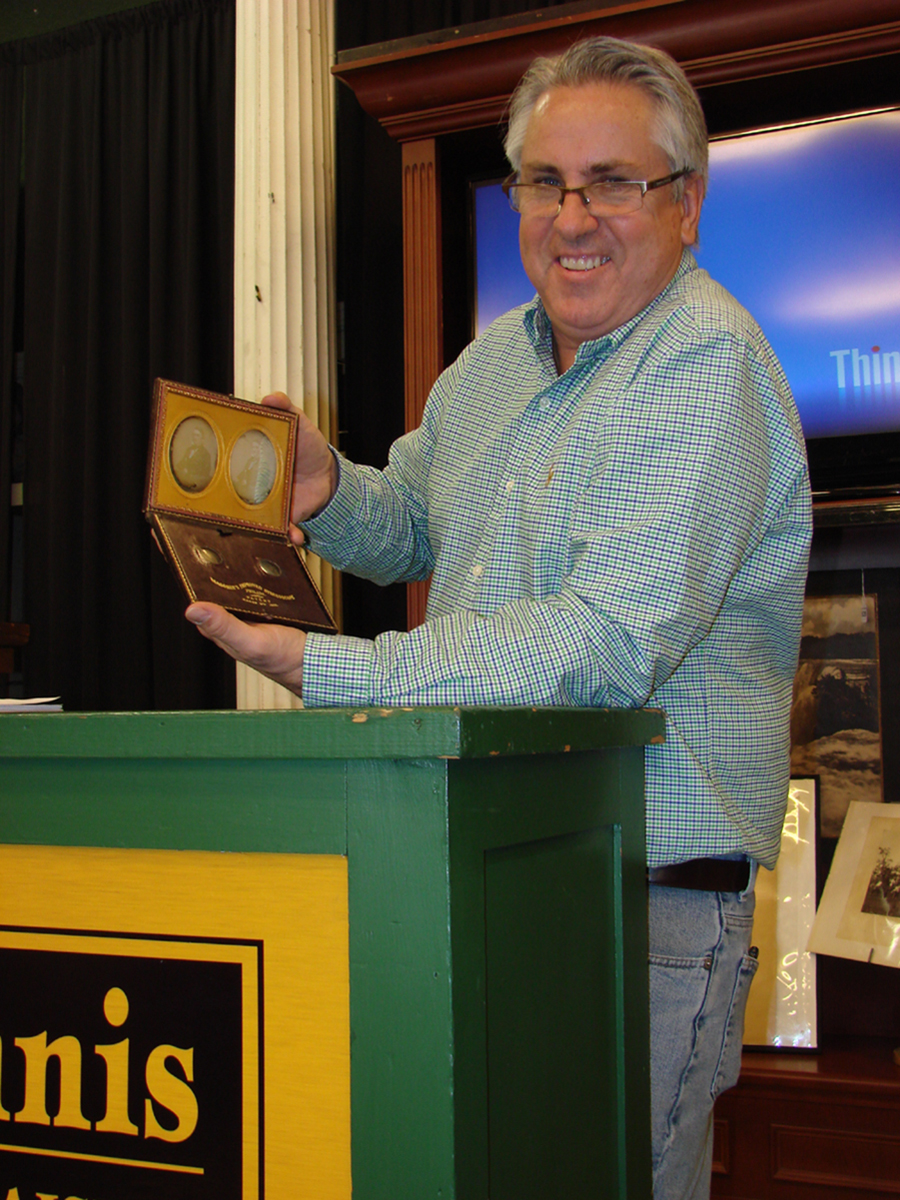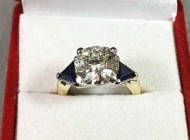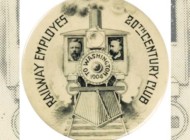Half Of Exonumia, Stamps & Photographica Offered Goes To Online Bidders
Review and Onsite Photos by Rick Russack;
Additional Photos Courtesy John McInnis Auctioneers
AMESBURY, MASS. — On April 2 and 3, John McInnis conducted two specialty sales that drew comments of “great stuff” from potential buyers during the relaxed previews. Day one sold more than 400 hundred lots, including a two-generation collection of stamps and flown covers and an outstanding accumulation of exonumia. Exonumia is broadly defined as including numismatic items other than coins and paper money: medals, encased postage stamps, trade tokens, love tokens, counterstamped coins and similar items. The exonumia came from a decrepit home in Ipswich, Mass., that has since been demolished.
The first 268 lots on day one were stamps, blocks and covers. It was a single-owner, two-generation collection that emphasized air mail issues, the 1893 Columbian Exposition issues and albums of early souvenir sheets. The albums of international souvenir sheets brought the strongest prices. These sheets were usually issued to commemorate philatelic expositions. A 1939 album with the sheets from Albania through the French Sudan, missing only the United States sheet, finished at $4,715, and a complete 1941 album, Germany through Nicaragua, plus several additional sheets, brought $5,865. A flown cover, with a $1.30 Graf Zeppelin stamp as well as a $2.60 one, issued for the first Pan-American round-the-world flight in 1930, sold for $403 to an Internet bidder. A cover for the 1933 Balbo Air Squadron flight from New York to Rome, with a total of five stamps, went out at $316. The attractive set of the 1933 Columbian Exposition stamps was sold stamp by stamp. As would be expected, a fairly well-centered $1 stamp, Scott #241, showing Queen Isabella pledging her jewels, brought the highest price, $345, while the one-cent issue, Scott #230, depicting Columbus sighting land, earned $35.
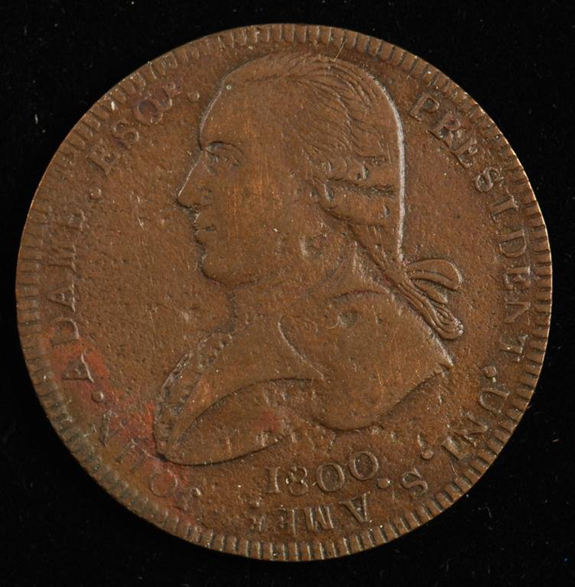
The highest priced item in the sale was this 1800 John Adams medal. It was made by A. Peasley, a maker of military buttons in Boston’ and realized $18,400.
There were several plate blocks, led by a block of 12 24-cent Curtis Biplane airmail stamps, which reached $690. A block of six 50-cent Airship Graf Zeppelin stamps realized $345, and a block of six 50-cent China Clipper airmail stamps fetched $230. A first day cover with a complete 1926 souvenir sheet, commemorating Alexander Hamilton’s battery at the 1776 Battle of White Plains, went for $518. The sheet contained 25 of the 2-cent stamps and was the first souvenir sheet issued in the United States. The print run was small, and full sheets are not common.
The collection of exonumia that came from the early home in Ipswich had been removed by McInnis a few years ago and has been offered in a series of sales. The house’s owner was a collector, or perhaps accumulator would be a better word. He bought the house with the original contents in 1960 and added stuff over the next 50-plus years. The owner’s exonumia collection included some outstanding material, along with some run-of-the-mill items.
Garnering the most presale interest was a John Adams 1800 presidential medal. The 1½-inch medal, probably of copper, had a bust portrait on the front, surrounded by the words “President Uni. S. America- 1800- John Adams Esq.” The verso had the wording “Pres Adams-Born Mass- Oct- 30-1735” surrounding “Vice President 1789,” and below the center it was stamped “A. Peasley DS.”
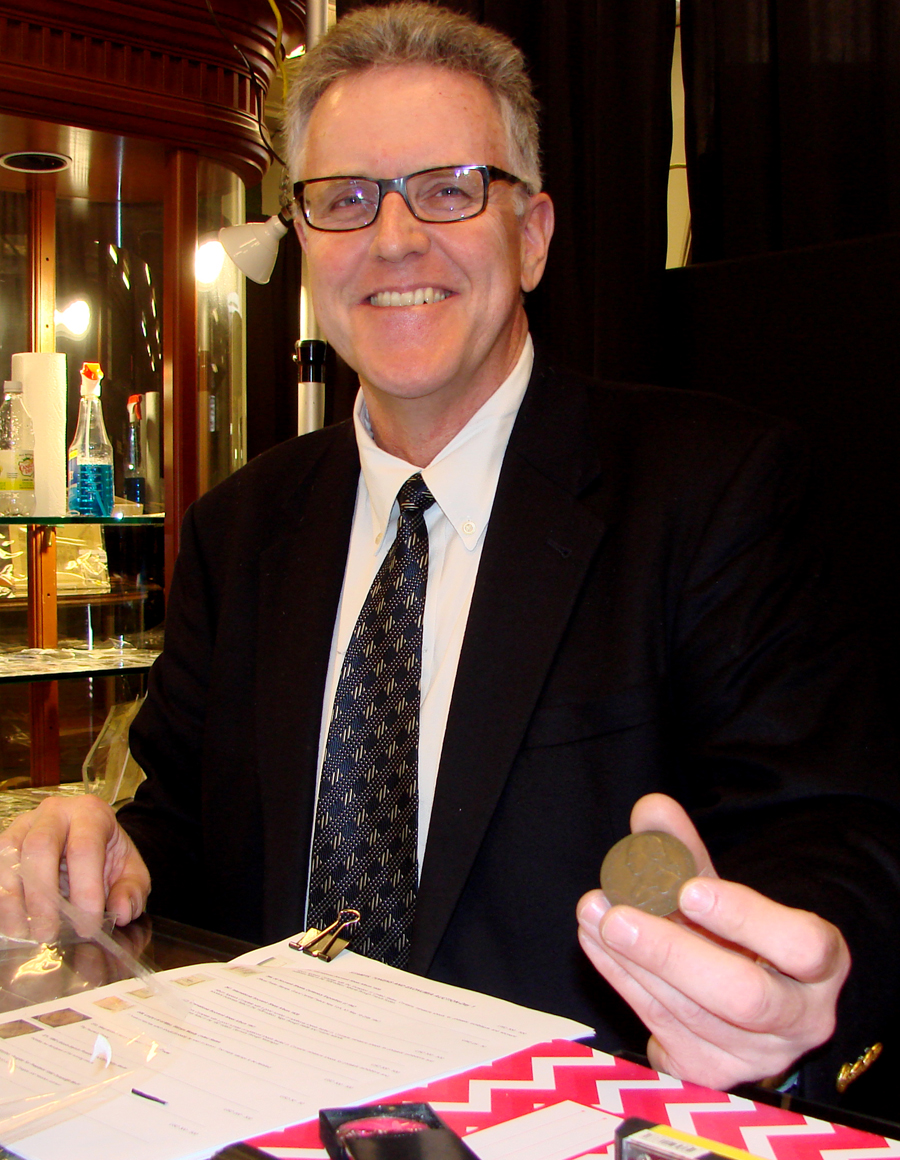
Gallery Director Dan Meader was holding the John Adams medal that brought the highest price of any item in the two-day sale.
Peasley was a button maker in Boston and supplied buttons for military uniforms. Rex Stark, prominent Gardner, Mass., dealer of political and historical Americana, paid $18,400 for the medal. He told Antiques and The Arts Weekly that he bought it for stock. “It will be in my next catalog,” he said. Stark’s fully illustrated, fixed price catalogs are issued four times a year; he does not sell on the Internet. This was the highest priced lot of the two-day auction, and Stark also bought the second highest priced lot. That was a group of 12 Civil War-era encased postage stamps. Encased postage stamps came into existence during the Civil War when merchants and citizens complained of a shortage of coins. The government authorized the use of postage stamps as temporary currency and John Gault, an American businessman, patented the idea of encasing the fragile stamps in a metal frame, usually brass, the backs of which were blank. He soon came up with a use for the backs, selling advertising space to merchants.
Examples with some names, such as Ayers Cathartic Pills, are fairly common. Some, such as one in this batch, are quite rare. It was issued in 1862 by Claflin’s Clothes, Hopkinton, Mass.. Stark paid $17,250 for this lot and told Antiques and The Arts Weekly that it was because of the Claflin item. He said some of the others, such as those marked Ayers, were almost throwaways. He competed with a phone bidder for the lot and later said, “I’m pretty sure I know who the underbidder was. He’ll probably call me later.”
There were a number of presidential campaign medals and buttons. An Andrew Jackson 1824 campaign medal brought $155, an 1852 Franklin Pierce campaign medal went for $132, and leading the group was an 1860 Lincoln and Hamlin ferrotype (tintype) campaign medal, which finished at $1,610. A lot of hard-times tokens brought $1,121, and a lot of 19 Civil War-era tokens fetched $949. An assortment of 24 countermarked coins, going as far back as 1806, went for $2,760. Stark explained that these were US coins that were stamped on the back by merchants as advertising. He said most were issued between 1840 to 1870. A lot of 53 “love tokens” earned $805. Stark explained that love tokens were coins, most often of silver, that friends and lovers had engraved with appropriate messages and were used as gifts.
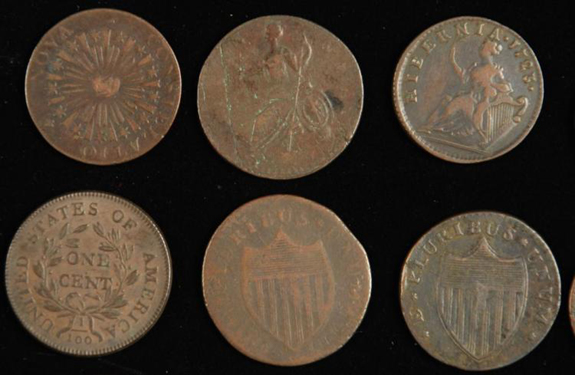
A group of 12 colonial and post-colonial coins sold for $7,763. The lot included a 1722 Rosa Americana coin, a 1723 Woods Hibernia coin and other scarce issues.
Photographica was sold on the second day of the sale, and the first lot was a 1/6th plate daguerreotype of a human skull with a bottle of poison next to it. An Internet bidder took it for $6,900. A 1/6th plate outdoor daguerreotype of a stone home with several gables sold for $1,115, and a quarter plate daguerreotype of a large Greek Revival building, with several men on the porch and a horse-pulled wagon, went for $2,185. It was cataloged as possibly being a daguerreian gallery. There were hundreds of daguerreotypes, many sold individually and many in lots.
Of interest to folk art collectors was a 1/6th plate daguerreotype copy of a Rufus Porter painting. It earned $575, and a daguerreotype of a Sharples portrait of George Washington went for $345. An occupational 1/6th plate daguerreotype of a man — perhaps a butcher, holding a fowl of some kind — finished at $1,840. Some images were “signed.” A 1/4 plate portrait of a gentleman, stamped “Plumb” on the brass frame, achieved $316. A stereo daguerreotype in a Mascher case of a gentleman with a cane reached $604. Other daguerreotypes sold between $25 and $200, depending on the level of interest in a particular image or the gutta percha case in which it was housed.
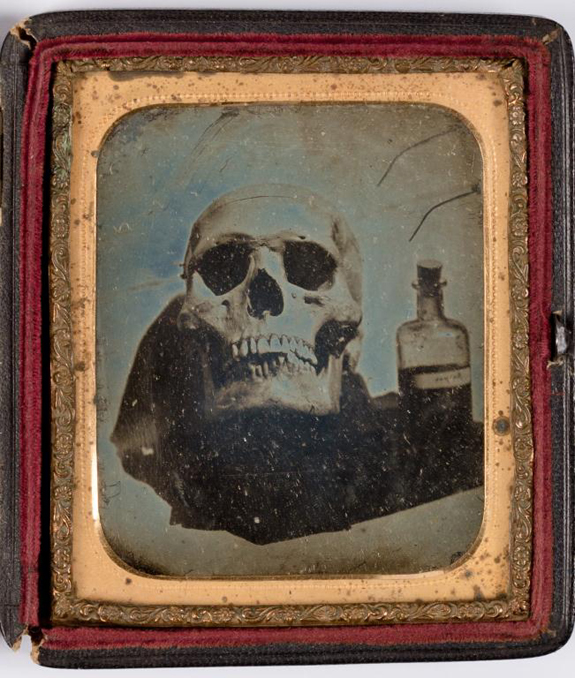
The first lot of the photography portion of the sale was a 1/6th plate daguerreotype of a human skull next to a bottle of poison. It was also the highest priced image, as it went out for $6,900 to an Internet bidder.
Some large albumen prints were included in the collection. A 7-by-9-inch Civil War photo by T.H. O’Sullivan, “US Military Construction Corps,” finished at $288, and a mammoth plate showing the officers of the First Infantry, Minnesota Volunteers, fetched $259. A carte de visite album with 30 Civil War leaders, including Lincoln, Grant, Sherman, Burnside and others, realized $805. A mammoth plate of Cathedral Rock in Yosemite by Carlton Watkins made $2,749, and another by the same photographer, Nevada Falls, also in Yosemite, went out for $1,553.
A tintype camera, capable of making four exposures at once, made by the Samuel Peck Co., circa 1865, was the highest priced camera in the sale, bringing $3,450. A group of Eastman string-pull cameras were popular with bidders A no. 1, circa 1892, brought $1,840; a no. 2, circa 1895, finished at $517; and a no. 3, circa 1895, earned $690. A Kodak Ordinary B went for $1,380, and a Blair Lucidograph folding plate camera, circa 1885, finished at $1,610. The only stereo box camera made by Kodak, a no. 2, circa 1901–05, realized $488. In all, there were about 70 cameras in the sale. Bidders in the room bought many of them, sometimes with competition from Internet bidders.
After the sale, McInnis told Antiques and The Arts Weekly that the sale easily exceeded the high estimates for the merchandise. “About 50 percent of the stuff was sold to online bidders, which is good for specialty sales like these. We had a lot of daguerreotypes and the prices remained strong for those throughout the sale. I thought the prices for all the photographica were strong. I wasn’t sure about how the in-house attendance would be but it was fine for both days.”
Prices reported include the buyer’s premium. For more information, 800-822-1417 or www.mcinnisauctions.com.

